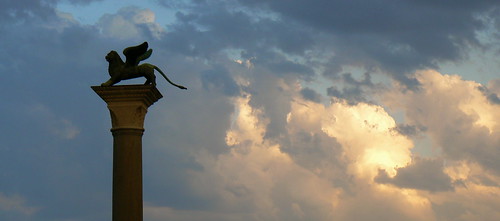 You cannot stray far in Venice without encountering images of the lion, the companion-creature of the City's patron saint, St Mark.
You cannot stray far in Venice without encountering images of the lion, the companion-creature of the City's patron saint, St Mark.The most famous of these creatures stands atop one of the two columns on the Piazetta San Marco, greeting travellers approaching the City across the lagoon.
Once covered in gold, the origin of this sculpture is much debated - it is thought to be either Etruscan, Persian or even Chinese.
Certainly, wherever the Venetians 'liberated' it from, they subsequently added the holy book on which its forepaws stand and the wings in order to make it a suitable pet for the Evangelist.
Certainly, wherever the Venetians 'liberated' it from, they subsequently added the holy book on which its forepaws stand and the wings in order to make it a suitable pet for the Evangelist.
Following the fall of the Venetian Republic, it was taken to Paris by Napoleon's army in 1797 (along with San Marco's famous horses) where it suffered the indignity of having its tail chopped off and then reattached between its legs before becoming part of a fountain! It was finally brought back to Venice, in pieces, in 1815 and reinstated on its column.
Many writers have speculated on this guardian angel-lion, among them - D H Lawrence in his poem, The Evangelistic Beasts...
There was a lion in Judah
Which whelped, and was Mark.
But winged.
A lion with wings.
At least at Venice.
Why should he have wings?
Is he to be a bird also?
Or a spirit?
Or a winged thought?
Or a soaring consciousness?
Evidently he is all that
The lion of the spirit.
It is thought that, before it was sanctified with wings, that the creature represented on the Piazetta in Venice was not intended to be a lion but the Chimera, the monstrous fire-breathing creature of Greek mythology that was composed of the parts of multiple animals and which was the origin of the term chimera, meaning an improbable fantasy.
If St Mark's Lion was (prior to its conversion to Christianity) a chimera, then it is a doubly appropriate heraldic creature for a city that is, itself, a fantastical illusion...
Images: Brian Sibley © 2009


3 comments:
I knew that about the Chimera! Because the word "chimérique" is used quite frequently in French; it means "fantastical".
I wish I could say the same about your cryptic crossword clue the other day! When do we get the answer?
horta : that is my word check for today... my favourite Art Nouveau designer! (& he's Belgian!)
You must have missed it, SUZANNE: Rob finally posted the answer and you'll find it in the 'comments' to the original post.
Oh good grief!
Post a Comment